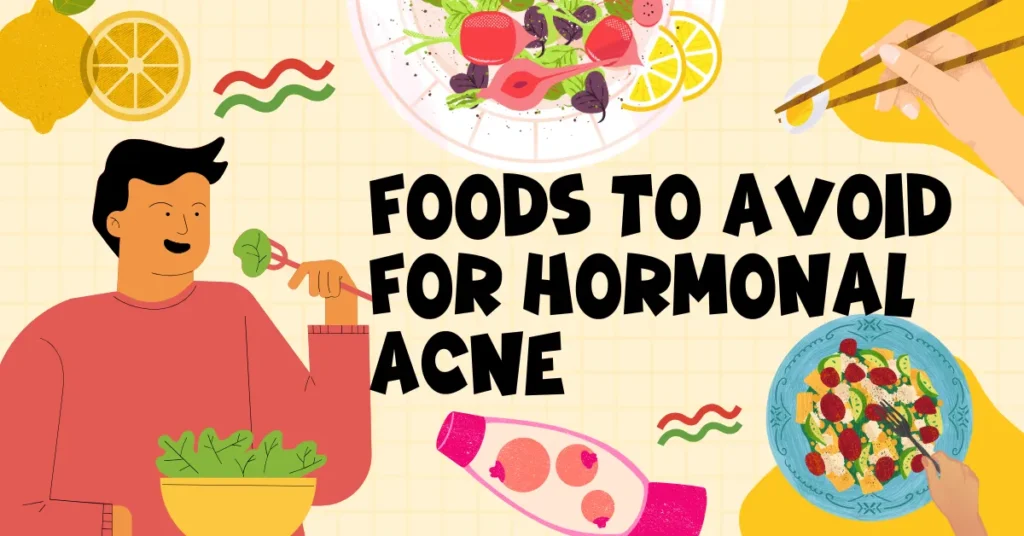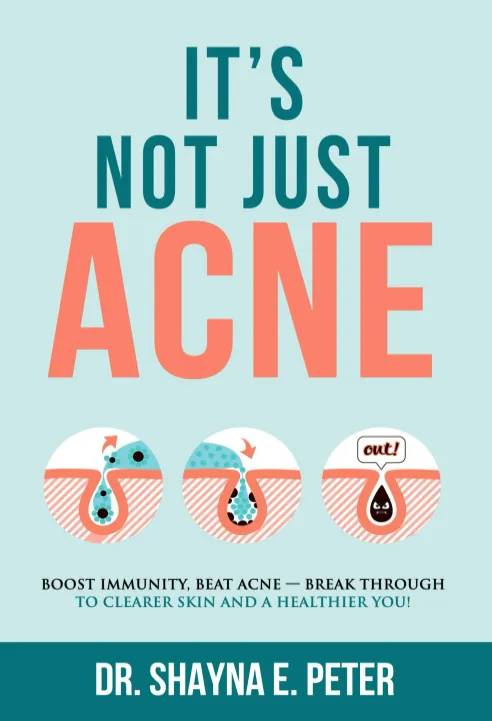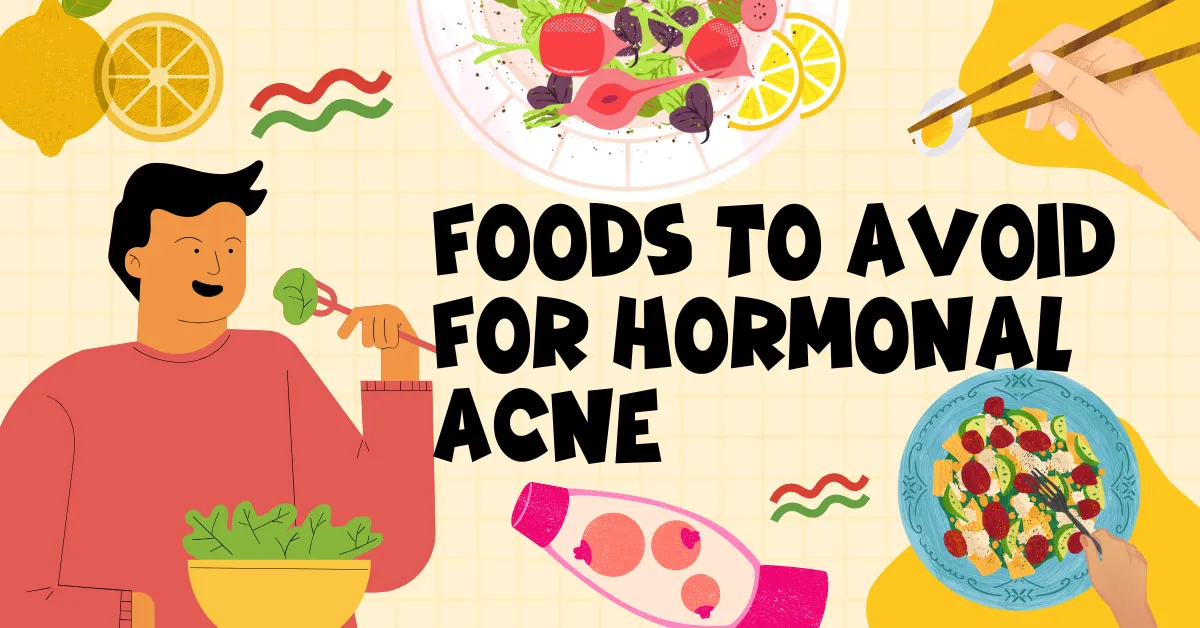Foods to avoid for hormonal acne
Hormonal acne affects millions of people worldwide, causing frustrating breakouts that seem to appear without warning and resist traditional treatments. While genetics and hormones play significant roles in acne development, emerging research reveals that diet can be a powerful trigger—or ally—in managing hormonal acne. Understanding which foods to avoid can be a game-changer in your journey toward clearer, healthier skin.
Understanding the Diet-Acne Connection
Recent scientific research has revolutionized our understanding of how food affects skin health. A comprehensive systematic review of 34 high-quality studies published in 2024 found that certain dietary patterns have a “modest yet significant” effect on acne development and severity PMC. The relationship is complex, involving hormonal pathways, inflammation, and insulin sensitivity—all of which can be influenced by what we eat.
The Hormonal Pathway
When you consume certain foods, particularly those high in sugars and refined carbohydrates, your body experiences a cascade of hormonal changes:
- Blood sugar spikes trigger insulin release
- Elevated insulin stimulates growth hormone production
- Growth hormones increase sebum (oil) production
- Excess sebum clogs pores and creates an environment for acne-causing bacteria
- Inflammation develops, leading to painful, persistent breakouts
This process is particularly problematic for those with hormonal acne, as their skin is already sensitive to hormonal fluctuations.

The Top Foods to Avoid for Hormonal Acne
1. High Glycemic Index Foods: The Primary Culprits
The strongest scientific evidence points to high glycemic index (GI) and glycemic load (GL) foods as major acne triggers. A systematic review found that 77% of studies supported this association, with randomized controlled trials confirming that low-GI diets significantly improve acne.
High-GI Foods to Eliminate:
Refined Grains and Starches:
- White bread and white rice
- Regular pasta (non-whole grain)
- Instant oatmeal and sugary cereals
- Crackers and pretzels
- White flour baked goods
- French fries and potato chips
Sugary Foods and Beverages:
- Soda and soft drinks
- Energy drinks and sports drinks
- Candy and sweets
- Cakes, cookies, and pastries
- Ice cream and frozen desserts
- Fruit juices (even 100% fruit juice)
Processed Snack Foods:
- Chips and crackers
- Granola bars (most commercial varieties)
- Instant noodles
- Microwave popcorn with added sugars
2. Dairy Products: The Controversial Connection
While the evidence for dairy is more complex than for high-GI foods, multiple studies have found positive associations between dairy consumption and acne, particularly in Western populations. A meta-analysis of studies found positive relationships between various dairy products and acne occurrence.
Dairy Products to Limit or Avoid:
Milk Products (Strongest Evidence):
- Skim milk (highest association with acne)
- Low-fat milk
- Whole milk
- Chocolate milk
- Milk-based protein shakes
Other Dairy Products:
- Ice cream
- Cottage cheese
- Processed cheese products
- Cream cheese
- Butter (in excess)
Note: Interestingly, fermented dairy products like yogurt and aged cheeses showed weaker associations with acne in some studies, possibly due to their probiotic content and different hormone profiles.
3. Whey Protein Supplements
Research specifically identifies whey protein as a potential acne trigger. A study found that 10% of acne patients consumed whey protein, and it was confirmed as a trigger for breakouts. This is particularly relevant for fitness enthusiasts who may unknowingly be sabotaging their skin health.
Protein Supplements to Avoid:
- Whey protein powder
- Mass gainers containing whey
- Protein bars with whey isolate
- Meal replacement shakes with dairy proteins
Better Alternatives:
- Plant-based protein powders (pea, hemp, rice)
- Collagen peptides
- Egg white protein (for those without egg sensitivities)
4. Processed and Fast Foods
Ultra-processed foods combine multiple acne triggers: high glycemic loads, unhealthy fats, excess sodium, and inflammatory ingredients.
Processed Foods to Eliminate:
- Fast food burgers and fried chicken
- Pizza (due to refined crust and processed cheese)
- Packaged snack cakes and cookies
- Instant and packaged meals
- Processed meats (hot dogs, deli meats with additives)
- Frozen dinners
5. Foods High in Omega-6 Fatty Acids
While not directly causing acne, foods high in omega-6 fatty acids can promote inflammation when consumed in excess, particularly when omega-3 intake is low.
High Omega-6 Foods to Limit:
- Vegetable oils (soybean, corn, sunflower, safflower)
- Foods fried in these oils
- Mayonnaise and salad dressings made with these oils
- Processed snack foods
- Nuts and seeds in excessive quantities (moderation is key)
6. Alcohol
Alcohol can worsen hormonal acne through multiple pathways:
- Increases inflammation
- Disrupts hormone balance
- Affects liver function (important for hormone metabolism)
- Often contains high amounts of sugar
- Can disrupt sleep patterns, affecting hormone regulation
Alcoholic Beverages to Limit:
- Beer (high in glycemic load)
- Sweet cocktails and mixed drinks
- Wine (in excess)
- Liqueurs and flavored spirits
7. Foods with Hidden Sugars
Many foods contain hidden sugars that can spike blood glucose and trigger acne.
Hidden Sugar Sources:
- Flavored yogurts
- Granola and “healthy” cereals
- Salad dressings and condiments
- Protein bars and “health” bars
- Dried fruits with added sugar
- Flavored coffee drinks
The Science Behind Food-Acne Mechanisms
Insulin and IGF-1 Pathways
When you consume high-GI foods, your body releases insulin to manage blood sugar. This insulin stimulates the production of insulin-like growth factor-1 (IGF-1), which:
- Increases sebum production
- Promotes keratinocyte proliferation (skin cell growth)
- Enhances androgen activity
- Triggers inflammatory cascades
Dairy and Hormone Disruption
Dairy products may contribute to acne through several mechanisms:
- Natural hormones: Milk contains hormones like IGF-1 and precursors to DHT (dihydrotestosterone)
- Protein effects: Whey and casein proteins may stimulate insulin and IGF-1 release
- Processing: Low-fat milk processing may concentrate hormone-active compounds
Inflammation and Oxidative Stress
Processed foods and high-sugar diets promote systemic inflammation through:
- Advanced glycation end products (AGEs) formation
- Increased reactive oxygen species
- Disruption of gut microbiome
- Activation of inflammatory pathways (NF-κB)
Individual Variations and Considerations
Genetic Factors
Not everyone responds to dietary triggers equally. Factors that influence individual sensitivity include:
- Genetic variations in insulin sensitivity
- Androgen receptor sensitivity
- Inflammatory response patterns
- Gut microbiome composition
Ethnicity and Cultural Diet Patterns
Research shows that the diet-acne relationship may be stronger in Western populations. Studies in non-Western countries sometimes show weaker or no associations between dairy and acne, possibly due to:
- Different processing methods
- Varying consumption patterns
- Genetic differences in dairy metabolism
- Overall dietary context
Gender Differences
Women may be more sensitive to dietary triggers due to:
- Hormonal fluctuations during menstrual cycles
- Greater insulin sensitivity variations
- Different fat distribution patterns
- Varying stress hormone responses
Creating Your Elimination Strategy
Phase 1: Identify Your Triggers (Weeks 1-4)
Week 1-2: High-GI Foods
- Eliminate all refined sugars and white flour products
- Replace with low-GI alternatives
- Monitor skin changes daily
Week 3-4: Dairy Elimination
- Remove all dairy products
- Use plant-based alternatives
- Continue avoiding high-GI foods
Phase 2: Systematic Reintroduction (Weeks 5-8)
- Reintroduce one food category at a time
- Wait 1-2 weeks between reintroductions
- Document skin reactions meticulously
- Note any delayed reactions (can occur 2-7 days later)
Phase 3: Personalized Plan (Week 9+)
- Create your personal “avoid” list based on observations
- Develop sustainable eating patterns
- Allow for occasional flexibility while maintaining awareness
What to Eat Instead: Building an Anti-Acne Diet
Low-GI Alternatives
Instead of white bread: Ezekiel bread, sourdough, or seed crackers Instead of white rice: Quinoa, cauliflower rice, or wild rice Instead of sugary snacks: Fresh berries, nuts, or vegetables with hummus Instead of pasta: Zucchini noodles, shirataki noodles, or legume-based pasta
Dairy Alternatives
Instead of cow’s milk: Unsweetened almond, oat, or coconut milk Instead of yogurt: Coconut yogurt or plant-based alternatives Instead of cheese: Nutritional yeast, cashew cheese, or avocado Instead of ice cream: Frozen fruit “nice cream” or coconut milk ice cream
Anti-Inflammatory Foods to Emphasize
Omega-3 Rich Foods:
- Wild-caught salmon and sardines
- Walnuts and flaxseeds
- Chia seeds and hemp hearts
Antioxidant-Rich Vegetables:
- Leafy greens (spinach, kale, arugula)
- Colorful bell peppers
- Broccoli and Brussels sprouts
- Sweet potatoes and carrots
Anti-Inflammatory Spices:
- Turmeric with black pepper
- Ginger and garlic
- Cinnamon and oregano
Meal Planning for Clear Skin
Sample Anti-Acne Day Menu
Breakfast:
- Smoothie with coconut milk, berries, spinach, and plant protein
- Steel-cut oats with nuts and cinnamon
- Green tea
Lunch:
- Large salad with mixed greens, avocado, and grilled chicken
- Olive oil and lemon dressing
- Quinoa or sweet potato
Dinner:
- Baked salmon with herbs
- Roasted vegetables (broccoli, carrots, zucchini)
- Brown rice or cauliflower rice
Snacks:
- Apple slices with almond butter
- Vegetables with hummus
- Herbal tea
Meal Prep Strategies
Batch Cooking:
- Prepare large quantities of low-GI grains
- Pre-cut vegetables for easy snacking
- Make dairy-free sauces and dressings
Smart Substitutions:
- Keep emergency snacks (nuts, seeds) available
- Learn to modify favorite recipes
- Experiment with new flavors and cuisines
Supplements to Consider
While food should be your primary focus, certain supplements may support clear skin:
Evidence-Based Supplements
Omega-3 Fatty Acids:
- Dosage: 1-2g EPA/DHA daily
- Reduces inflammation and sebum production
Zinc:
- Dosage: 30-40mg daily (with food to prevent nausea)
- Anti-inflammatory and antibacterial properties
Probiotics:
- Multi-strain formulations
- Support gut health and reduce inflammation
Vitamin D:
- Dosage: 1000-4000 IU daily (based on blood levels)
- Anti-inflammatory and immune-supporting
Monitoring Progress and Adjusting Your Approach
Tracking Methods
Skin Diary:
- Daily photos of affected areas
- Rate breakouts on a 1-10 scale
- Note location and type of blemishes
Food Log:
- Track everything you eat and drink
- Note timing of meals
- Include stress levels and sleep quality
Symptom Tracking:
- Energy levels
- Digestive health
- Mood changes
- Menstrual cycle patterns (for women)
Timeline Expectations
Week 1-2: May see initial improvements or temporary worsening Week 3-6: More consistent improvements should emerge Week 6-12: Significant changes typically become apparent 3+ months: Full benefits of dietary changes usually manifest
Common Challenges and Solutions
Social Situations
Dining Out:
- Ask about ingredients and preparation methods
- Focus on grilled proteins and vegetables
- Research menus in advance
- Bring your own salad dressing if necessary
Family Meals:
- Communicate your needs clearly
- Offer to contribute compliant dishes
- Have backup snacks available
- Focus on the social aspect rather than just food
Cravings and Emotional Eating
Managing Sugar Cravings:
- Keep fresh fruit available
- Try herbal teas with natural sweetness
- Address underlying nutrient deficiencies
- Ensure adequate protein and fat intake
Stress Eating:
- Develop non-food coping strategies
- Practice mindfulness techniques
- Ensure adequate sleep
- Consider professional support if needed
When to Seek Professional Help
Dermatological Support
Consider seeing a dermatologist if:
- Acne is severe or cystic
- Dietary changes don’t improve symptoms after 3 months
- You develop scarring
- Acne significantly impacts quality of life
Nutritional Guidance
A registered dietitian can help with:
- Creating balanced elimination diets
- Ensuring nutritional adequacy
- Managing eating disorders or disordered eating
- Addressing digestive issues
Hormonal Evaluation
Consider hormonal testing if:
- Acne coincides with irregular periods
- You have signs of insulin resistance
- There’s excessive hair growth or hair loss
- Weight gain or difficulty losing weight
Long-term Success Strategies
Building Sustainable Habits
Start Small:
- Make one change at a time
- Focus on additions before subtractions
- Celebrate small victories
- Allow for learning curves
Flexibility and Balance:
- Aim for 80/20 compliance
- Plan for special occasions
- Don’t let perfection become the enemy of progress
- Maintain perspective on overall health
The Holistic Approach
Remember that clear skin involves more than just diet:
- Stress management: Meditation, yoga, adequate sleep
- Skincare routine: Gentle, non-comedogenic products
- Physical activity: Regular exercise supports hormone balance
- Hydration: Adequate water intake for skin health
Conclusion: Your Path to Clearer Skin
The relationship between diet and hormonal acne is complex but increasingly well-understood. By avoiding high glycemic index foods, limiting dairy products, and eliminating processed foods, many people see significant improvements in their skin health. The key is patience, consistency, and individualization—what triggers acne in one person may not affect another.
Remember that dietary changes for acne are not about restriction but about nourishment. By focusing on whole, unprocessed foods that support stable blood sugar and reduce inflammation, you’re not only improving your skin but also your overall health and energy levels.
The journey to clear skin through dietary changes requires commitment and patience, but the results can be life-changing. Start with the foods that have the strongest scientific evidence—high-GI foods and dairy—and gradually build a personalized approach that works for your lifestyle and skin.
Most importantly, be kind to yourself throughout this process. Healing takes time, and everyone’s journey is different. With consistency, patience, and the right knowledge, clearer skin and improved confidence are within your reach.
That Feeling When Knee Surgery is Tomorrow: A Journey Through Anticipation, Fear, and Hope
There’s a unique cocktail of emotions that floods your system when you realize that tomorrow—just hours away—you’ll be going under the knife. If you’re reading this the night before your knee surgery, chances are you’re experiencing a whirlwind of feelings that range from relief that help is finally coming, to anxiety about the unknown ahead. You’re not alone in this feeling, and everything you’re experiencing right now is completely normal.
The Night Before: A Mental and Emotional Landscape
The Relief-Anxiety Paradox
Tonight, you might find yourself caught between contradictory emotions. There’s relief—finally, after months or years of pain, instability, or limited mobility, tomorrow brings the promise of healing. Your knee, which has been betraying you on stairs, during sports, or even just walking across a room, will finally get the attention it needs.
But alongside that relief sits anxiety, like an uninvited guest that won’t leave. The fear isn’t necessarily about the surgery itself—modern orthopedic procedures are incredibly safe and effective. It’s more about the unknown. What will recovery feel like? How long will it take? Will you be back to normal? These questions circle in your mind like planes waiting to land.
The Physical Sensations of Pre-Surgery Nerves
Your body is probably telling its own story tonight. Maybe your stomach feels unsettled, despite following the fasting instructions. Your heart might be beating a little faster than usual. Sleep feels elusive, even though you know rest would be good for tomorrow. These physical manifestations of emotional stress are your body’s way of preparing for what it perceives as a significant event.
Some people describe feeling hyperaware of their knee tonight—almost like it knows what’s coming. You might find yourself unconsciously protecting it more than usual, or conversely, testing its limits one last time before tomorrow’s intervention.
Understanding What You’re Feeling: The Psychology of Pre-Surgery Emotions
Fear of the Unknown
Human beings are naturally wired to fear the unknown, and surgery represents a significant departure from your normal routine and control. You’re about to trust your body—and specifically, a part of your body that’s been causing problems—to someone else’s hands. This temporary loss of control can feel overwhelming.
It’s important to recognize that this fear serves an evolutionary purpose. It’s your brain’s way of making sure you’ve considered all the angles, prepared as much as possible, and taken the situation seriously. In a way, your anxiety is proof that you’re taking good care of yourself.
Anticipatory Grief
Sometimes, the emotions before surgery include a form of grief—grief for the temporary loss of independence, for the disruption to your routine, or even for saying goodbye (hopefully permanently) to the knee that’s been part of your story, even if it’s been a painful part.
If you’re an athlete or someone whose identity is closely tied to physical activity, this grief might feel particularly acute. You’re not just having surgery; you’re temporarily pausing a part of who you are.
Hope and Optimism Fighting for Space
Beneath the worry, there’s probably hope—maybe cautious hope, but hope nonetheless. Hope that this time next month, you’ll be moving differently. Hope that the activities you’ve been avoiding will become possible again. Hope that sleep won’t be interrupted by knee pain, or that you’ll be able to play with your kids or grandkids without limitation.
This hope is precious and valid, even if it feels scary to fully embrace it. You’ve probably been disappointed by your knee before, so allowing yourself to hope for significant improvement requires vulnerability.
The Practical Side: What Tomorrow Actually Looks Like
The Morning Routine
Tomorrow will start early, probably earlier than you usually wake up. You’ll shower with the special soap they gave you, put on comfortable clothes (likely something that accommodates post-surgery swelling and bandages), and make your way to the hospital or surgery center.
The pre-operative routine is designed to be calming and efficient. You’ll check in, change into a hospital gown, and meet with various members of your surgical team. Each person you meet—from the pre-op nurse to the anesthesiologist to your surgeon—is there specifically to ensure your safety and success.
The People Taking Care of You
Your surgical team has done this procedure hundreds, if not thousands, of times. For you, this is a major life event. For them, this is Tuesday (or whatever day your surgery falls on). This isn’t to minimize your experience, but rather to emphasize that you’re in incredibly capable hands.
Your surgeon chose to specialize in orthopedics because they want to help people move better and live with less pain. Your anesthesiologist’s job is to ensure you’re comfortable and safe throughout the procedure. The surgical nurses coordinate everything to make sure the process goes smoothly.
The Recovery Room: Your First Stop After
When you wake up, you’ll probably feel groggy and disoriented—this is completely normal and temporary. The recovery room nurses are experts at helping people transition from anesthesia back to consciousness. They’ll monitor your vital signs, manage any discomfort, and help you understand what happens next.
Your knee will likely be bandaged and possibly in a brace or immobilizer. It might feel strange—numb from the nerve block, swollen, or just different than it felt before. This is all part of the healing process beginning.
Types of Knee Surgery: Understanding Your Specific Journey
Arthroscopic Procedures
If you’re having arthroscopic surgery—whether for a meniscus repair, ligament reconstruction, or cartilage treatment—your recovery will likely be faster than with open surgery. The small incisions heal quickly, and many people are surprised by how manageable the immediate post-operative period is.
Arthroscopic surgery often allows for same-day discharge, meaning you’ll likely be home tomorrow evening. The first few days involve managing swelling, gradually increasing mobility, and beginning gentle rehabilitation exercises.
ACL Reconstruction
ACL reconstruction is a common procedure, especially among athletes and active individuals. If this is your surgery, you’re joining a large community of people who’ve successfully returned to their activities after this procedure.
The initial recovery focuses on protecting the graft while your body begins the process of incorporating the new tissue. Physical therapy will be a significant part of your journey, but it’s also the pathway back to the activities you love.
Meniscus Surgery
Meniscus procedures vary widely, from simple trimming of torn tissue to complex repairs. Your specific procedure will determine your recovery timeline, but most people are pleasantly surprised by how quickly they feel improvement in their day-to-day activities.
Total or Partial Knee Replacement
If you’re having a knee replacement, you’re taking a significant step toward pain relief and improved function. While the recovery is longer than with arthroscopic procedures, the long-term results are often life-changing for people who’ve been living with chronic knee pain.
Replacement surgery requires a hospital stay and a more intensive rehabilitation process, but it also offers the possibility of decades of improved mobility and reduced pain.
Coping Strategies for Tonight and Tomorrow
Breathing and Relaxation Techniques
When anxiety peaks, return to your breath. Try the 4-7-8 technique: inhale for 4 counts, hold for 7, exhale for 8. This activates your parasympathetic nervous system and can help calm both your mind and body.
Progressive muscle relaxation can also help. Starting with your toes and working up to your head, tense and then relax each muscle group. Pay special attention to areas where you hold stress—your shoulders, jaw, or forehead.
Mindfulness and Present-Moment Awareness
Your mind might be racing toward tomorrow, next week, or next month. Gently bring your attention back to right now. What do you hear? What do you feel? What do you see? Grounding yourself in the present moment can provide relief from anticipatory anxiety.
Remember that right now, in this moment, you’re safe. Your knee might hurt, but you’re not in surgery yet. You don’t need to experience tomorrow’s events tonight.
Positive Visualization
Spend some time imagining your recovery going well. Picture yourself walking without pain, returning to activities you enjoy, or simply sleeping through the night without knee discomfort. While it’s important not to ignore legitimate concerns, deliberately cultivating positive mental images can help balance anxiety with hope.
Connecting with Your Support System
If you have family or friends who will be with you tomorrow, take comfort in their presence tonight. Talk about your feelings if that helps, or simply enjoy their company as a distraction from tomorrow’s events.
If you’re going through this alone, remember that independence is a strength, and your medical team will provide the professional support you need. Many people find that facing challenges independently builds confidence and resilience.
What Your Knee Surgery Says About You
You’re Brave
Choosing to have surgery—even necessary surgery—requires courage. You’ve decided that the potential benefits outweigh the risks and discomfort. You’ve chosen active treatment over passive acceptance of limitation and pain. This takes bravery.
You’re Invested in Your Future
By having this surgery, you’re making a statement about your expectations for your life. You’re saying that you want to move better, feel better, and do more. You’re investing in your future mobility and quality of life.
You’re Taking Control
Living with knee problems often means feeling like your body is in control rather than you. Surgery represents taking control back—making an active choice to address the problem rather than just managing around it.
The Recovery Journey: What Lies Ahead
The First Week: Healing Begins
The first week after surgery is about protecting your healing tissues while managing swelling and discomfort. You’ll likely have some combination of ice, elevation, pain medication, and gentle movement as prescribed by your surgical team.
This week requires patience with yourself. Your energy levels might be lower than usual as your body dedicates resources to healing. Simple tasks might take more effort. This is temporary and normal.
Weeks 2-6: Gradual Progress
Depending on your specific surgery, this period typically involves gradually increasing activity and beginning formal physical therapy. You’ll start to see and feel progress, though it might be slower than you’d like.
Physical therapy becomes your partner in recovery. Your therapist will guide you through exercises designed to restore strength, flexibility, and function while protecting your healing tissues.
Months 2-6: Building Strength and Function
This phase is often where the real work happens. You’ll progressively challenge your knee with more demanding exercises and activities. The improvements during this time can be dramatic and motivating.
You might return to work, resume driving, and begin participating in recreational activities again. Each milestone represents a victory and a step closer to your goals.
Beyond Six Months: Return to Life
For many procedures, the six-month mark represents a significant milestone. By this time, most people have returned to their desired activities, though some might still be working toward specific goals like competitive sports.
The knee that’s been a problem becomes a non-issue. You stop thinking about it during daily activities. You trust it again.
Managing Expectations: The Reality of Recovery
It’s Not Always Linear
Recovery doesn’t follow a straight line. You might have days that feel like setbacks, followed by periods of rapid improvement. This is normal and doesn’t indicate that anything is wrong.
Some days your knee might feel stiff or sore, especially in the early weeks. Weather changes, activity level, and even stress can affect how your knee feels during recovery.
Everyone’s Timeline is Different
Your recovery will be unique to you, influenced by factors like your age, overall health, the specific procedure, your activity level, and how well you follow your rehabilitation program. Comparing your progress to others can be discouraging and isn’t helpful.
Trust your surgical team’s timeline and guidance. They know your specific situation and can best advise when you’re ready for each phase of recovery.
The Importance of Patience
One of the hardest parts of recovery is often the mental challenge of being patient with the process. Our culture values quick fixes and immediate results, but tissue healing follows biological timelines that can’t be rushed.
The patience you develop during recovery often serves you well in other areas of life. Many people find that going through surgery and rehabilitation teaches them valuable lessons about perseverance and self-compassion.
It’s Not Just Acne: Boost Immunity, Beat Acne – Break Through to Clearer Skin & A Healthier You!
Tired of spinning your wheels trying any and everything to clear up your skin?
Do you worry acne will haunt you your entire life? Can’t stand looking in the mirror? Are you tired of useless one-size-fits-all treatments?
It’s Not Just Acne is the answer to your prayers – a groundbreaking look at skincare that dives well below the surface to help you understand.

Finding Meaning in the Experience
An Opportunity for Reflection
Surgery and recovery create a natural pause in your usual routine. This can be an opportunity to reflect on what’s important to you, what activities you want to prioritize when you’re fully recovered, and how you want to take care of your body going forward.
Some people use their recovery time to develop new hobbies, reconnect with friends and family, or simply rest in ways they haven’t allowed themselves to do in years.
Building Resilience
Going through surgery and recovery successfully builds confidence in your ability to handle challenges. You’re proving to yourself that you can face uncertainty, manage discomfort, and work toward long-term goals.
This resilience extends beyond your knee. The mental skills you develop during recovery—patience, persistence, and self-advocacy—serve you in many areas of life.
Appreciation for Movement
Many people report a renewed appreciation for movement and physical activity after knee surgery. Activities you might have taken for granted—walking without pain, climbing stairs easily, or playing with children—become sources of joy and gratitude.
Practical Preparations for Tomorrow
What to Bring
Pack light for tomorrow. You’ll need your ID, insurance cards, and a list of current medications. Comfortable, loose-fitting clothes are important—think sweatpants or shorts that will accommodate post-surgery swelling and bandages.
If you’re staying overnight, bring basics like a toothbrush, but the hospital will provide most of what you need. A phone charger might be helpful for staying connected with family and friends.
Arrange Your Recovery Space
When you get home, you’ll want easy access to everything you need. Set up a comfortable spot with pillows for elevation, easy access to ice packs, medications, water, and entertainment like books or a tablet.
If your bedroom is upstairs, consider setting up a temporary sleeping area on the main floor for the first few days, especially if you’re having a more involved procedure.
Final Instructions
Follow your pre-operative instructions carefully, especially regarding eating and drinking restrictions. These guidelines are for your safety and following them helps ensure your surgery can proceed as scheduled.
Take your prescribed medications as directed, including any pre-operative antibiotics if prescribed. If you have questions about any instructions, call your surgeon’s office rather than guessing.
A Letter to Your Future Self
Tomorrow night, you’ll be on the other side of this surgery. You’ll have taken the step that tonight feels so daunting. You’ll know what it felt like, how the team took care of you, and how your knee feels with the repair or replacement beginning to heal.
A week from now, you’ll likely feel significantly more confident about your decision. The acute post-operative phase will be behind you, and you’ll be starting to see the benefits of the procedure.
A month from now, you’ll probably be amazed at how much better you feel and how quickly the time passed. The anxiety you feel tonight will be a memory, replaced by satisfaction with your progress.
Six months from now, if someone asks you about your knee surgery, you’ll likely describe it as one of the best decisions you’ve made. The temporary discomfort and inconvenience will seem small compared to the long-term benefits.
Words of Encouragement
You’ve made it this far—through the decision to have surgery, the consultations, the preparation, and now to the night before. That demonstrates strength, wisdom, and commitment to your health and future.
Tomorrow’s surgical team has prepared extensively for your procedure. They’ve chosen their profession because they want to help people like you move better and live with less pain. You’re not just another case to them; you’re someone whose life they have the opportunity to improve.
Your body has an remarkable ability to heal. Given the right conditions—which surgery provides—your tissues will repair, strengthen, and adapt. Trust in your body’s healing capacity, your surgeon’s skill, and your own resilience.
This journey you’re beginning isn’t just about fixing a knee. It’s about reclaiming activities you love, moving through life with confidence, and proving to yourself that you can face challenges and come out stronger.
Final Thoughts for Tonight
As you prepare for sleep tonight (or try to), remember that it’s okay to feel anxious. It’s okay to have questions. It’s okay to feel emotional about tomorrow. All of these responses are normal and human.
You don’t have to be perfect tomorrow. You don’t have to be brave every moment. You just have to show up, trust your team, and begin the healing process.
Tomorrow evening, you’ll be reading or watching something to pass the time during early recovery, and tonight’s anxiety will already be transforming into relief and hope for the future.
Rest as well as you can. Tomorrow is going to be a good day—not easy, necessarily, but good. It’s the beginning of your knee feeling better, moving better, and serving you better for years to come.
You’ve got this. Tomorrow, and all the days that follow, you’ve got this.
Sweet dreams, and here’s to your successful surgery and smooth recovery ahead.






